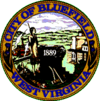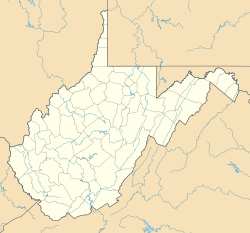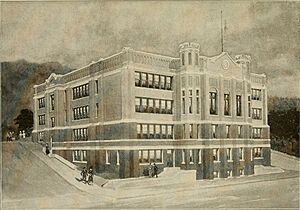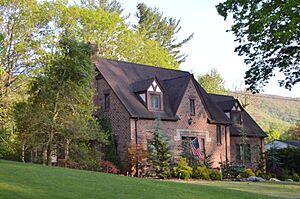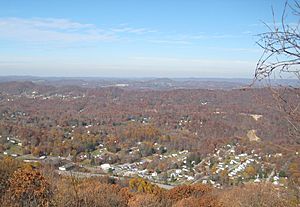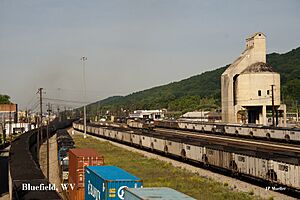Bluefield, West Virginia facts for kids
Quick facts for kids
Bluefield, West Virginia
|
|||
|---|---|---|---|
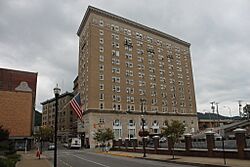
Bluefield Downtown Commercial Historic District
|
|||
|
|||
| Nickname(s):
Nature's Air Conditioned City
|
|||
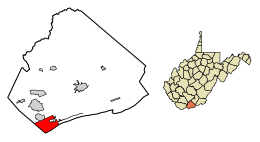
Location of Bluefield in Mercer County, West Virginia.
|
|||
| Country | United States | ||
| State | West Virginia | ||
| County | Mercer | ||
| Area | |||
| • City | 9.03 sq mi (23.39 km2) | ||
| • Land | 9.03 sq mi (23.39 km2) | ||
| • Water | 0.00 sq mi (0.00 km2) | ||
| Elevation | 2,631 ft (802 m) | ||
| Population
(2020)
|
|||
| • City | 9,658 | ||
| • Density | 1,069/sq mi (412.9/km2) | ||
| • Metro | 106,363 | ||
| Time zone | UTC−5 (EST) | ||
| • Summer (DST) | UTC−4 (EDT) | ||
| ZIP code |
24701
|
||
| Area codes | 304, 681 | ||
| FIPS code | 54-08524 | ||
| GNIS feature ID | 2390566 | ||
Bluefield is a city located in Mercer County, West Virginia, in the United States. In 2020, about 9,658 people lived here. It's the main city in the larger Bluefield area, which includes parts of Virginia and has a population of over 106,000 people.
Contents
History of Bluefield
The story of Bluefield began in the 1700s. The Davidson and Bailey families were among the first European settlers. They built a small village in a wild part of what is now southern West Virginia. This village had a mill, a church, and a school. They even built a fort to protect themselves from the Shawnee tribe. The Shawnee had a village nearby on the Bluestone River.
In 1882, the Davidson and Bailey families sold some of their land. This happened when Captain John Fields of the Norfolk and Western Railway started building a new railroad. The city is often thought to be named after the blue chicory flowers. These flowers make the fields look purplish-blue in the summer. However, some research suggests the name might come from the coal fields. These coal fields were developed near the Bluestone River.
The Coal Rush and Growth
Under the land of the early settlers lay huge amounts of bituminous coal. This was one of the richest coal deposits in the world. The first coal was found in nearby Pocahontas, Virginia. Frederick J. Kimball, who was the president of the Norfolk and Western Railway, called it an amazing discovery. Even Thomas Jefferson had mentioned this coal much earlier. But it wasn't until 1882 that people started mining it.
Coal mines grew quickly in the area. This included places like Bluefield, War, and Pocahontas. Together, these were known as the Pocahontas Coal Fields. They played a big part in the Industrial Revolution in the United States. The coal industry brought a lot of money and jobs to the area. Many workers came here, including immigrants from Europe and African Americans from the southern states. They all came looking for industrial work.
In the late 1800s, the Norfolk and Western Railway Company chose Bluefield for a big repair center. This made the town grow very fast. In just one year, from 1887 to 1888, train travel increased by 317%. Bluefield grew so quickly, it seemed to appear "overnight." This rapid growth caused some problems. There wasn't enough housing for everyone. Workers crowded into older homes.
The city's success depended a lot on the Norfolk and Western Railroad. Bluefield became a busy city with a lively atmosphere. It was described as having a mix of Chicago, New York, and Pittsburgh. It was a tough city with steel and coal at its heart.
The coal boom brought a lot of wealth. Nearby Bramwell, a town started in 1888, was known as the "Millionaires' Town." It had more millionaires per person than anywhere else. It also had more cars per person. In 1889, Bluefield officially became a city.
Bluefield was also home to the Bluefield Colored Institute. This was an historically black college founded in 1895. Today, it is known as Bluefield State University.
Bluefield in the 20th Century
In the 1920s, the twelve-story West Virginian Hotel was built. Today, it is used as a retirement home. In 1924, the nearby town of Graham, Virginia, changed its name to Bluefield. They hoped to unite the two towns.
Many famous people have connections to Bluefield. Nobel Prize-winning mathematician John Forbes Nash was born here in 1928. George Marshall Palmer, a Purdue University professor, was also born in Bluefield in 1921. He was important in the invention of the Boeing wind tunnel.
The Great Depression in the 1930s was very hard on Bluefield. The city faced financial problems. After several big fires destroyed parts of downtown, the city was almost ruined. Things only got better when World War II started. Coal production became important again. Bluefield was so important that it was even on a list of possible German air raid targets during the war. Air raid drills were common in the city.
In 1974, the Interstate Highway System was built through East River Mountain. This made it easier for cars to reach the city. However, people relied less on railroads. This change caused Bluefield to lose jobs and population. Its Amtrak train station closed in the 1980s. The main shopping mall, Mercer Mall, opened in 1980.
Geography
Bluefield is located in the Appalachian Mountains of West Virginia. It is right across the state border from Bluefield, Virginia.
The city covers an area of about 9.03 square miles (23.39 square kilometers). All of this area is land.
Climate and Weather
Bluefield is a mountain city. It has a climate with moderately cold, snowy winters. Summers are pleasantly warm to hot. The average temperature in January is about 31.9°F (–0.1°C). In July, it's about 70.3°F (21.3°C).
On average, there are only a few days each year when the temperature reaches 90°F (32°C) or higher. It also rarely drops to 0°F (–18°C) or lower. The highest temperature ever recorded was 99°F (37°C) in July 1952 and August 1957. The coldest was –25°F (–32°C) in December 1917.
| Climate data for Bluefield, West Virginia (Mercer County Airport), 1991–2020 normals, extremes 1909–present | |||||||||||||
|---|---|---|---|---|---|---|---|---|---|---|---|---|---|
| Month | Jan | Feb | Mar | Apr | May | Jun | Jul | Aug | Sep | Oct | Nov | Dec | Year |
| Record high °F (°C) | 75 (24) |
75 (24) |
87 (31) |
90 (32) |
92 (33) |
97 (36) |
99 (37) |
99 (37) |
96 (36) |
88 (31) |
83 (28) |
78 (26) |
99 (37) |
| Mean maximum °F (°C) | 63 (17) |
65 (18) |
73 (23) |
81 (27) |
84 (29) |
86 (30) |
88 (31) |
87 (31) |
85 (29) |
79 (26) |
72 (22) |
65 (18) |
89 (32) |
| Mean daily maximum °F (°C) | 39.9 (4.4) |
43.4 (6.3) |
51.4 (10.8) |
62.7 (17.1) |
69.7 (20.9) |
76.0 (24.4) |
78.9 (26.1) |
77.9 (25.5) |
72.5 (22.5) |
62.8 (17.1) |
52.2 (11.2) |
43.2 (6.2) |
60.9 (16.1) |
| Daily mean °F (°C) | 31.9 (−0.1) |
34.9 (1.6) |
42.2 (5.7) |
52.7 (11.5) |
60.3 (15.7) |
67.1 (19.5) |
70.3 (21.3) |
69.3 (20.7) |
63.5 (17.5) |
53.7 (12.1) |
43.5 (6.4) |
35.5 (1.9) |
52.1 (11.2) |
| Mean daily minimum °F (°C) | 23.8 (−4.6) |
26.5 (−3.1) |
33.0 (0.6) |
42.6 (5.9) |
50.9 (10.5) |
58.3 (14.6) |
61.8 (16.6) |
60.7 (15.9) |
54.5 (12.5) |
44.6 (7.0) |
34.7 (1.5) |
27.9 (−2.3) |
43.3 (6.3) |
| Mean minimum °F (°C) | 4 (−16) |
9 (−13) |
14 (−10) |
26 (−3) |
37 (3) |
48 (9) |
54 (12) |
54 (12) |
42 (6) |
30 (−1) |
19 (−7) |
11 (−12) |
1 (−17) |
| Record low °F (°C) | −21 (−29) |
−9 (−23) |
−2 (−19) |
11 (−12) |
24 (−4) |
31 (−1) |
38 (3) |
39 (4) |
29 (−2) |
13 (−11) |
−5 (−21) |
−25 (−32) |
−25 (−32) |
| Average precipitation inches (mm) | 3.03 (77) |
2.90 (74) |
3.84 (98) |
3.64 (92) |
4.61 (117) |
4.14 (105) |
4.36 (111) |
3.14 (80) |
3.24 (82) |
2.78 (71) |
2.55 (65) |
3.01 (76) |
41.24 (1,047) |
| Average snowfall inches (cm) | 9.9 (25) |
8.8 (22) |
6.5 (17) |
0.9 (2.3) |
0.0 (0.0) |
0.0 (0.0) |
0.0 (0.0) |
0.0 (0.0) |
0.0 (0.0) |
0.5 (1.3) |
1.4 (3.6) |
6.6 (17) |
34.6 (88) |
| Average precipitation days (≥ 0.01 in) | 13.5 | 13.5 | 15.3 | 13.7 | 15.4 | 13.7 | 13.6 | 11.4 | 10.0 | 10.2 | 10.5 | 13.4 | 154.2 |
| Average snowy days (≥ 0.1 in) | 6.6 | 6.3 | 4.1 | 1.1 | 0.0 | 0.0 | 0.0 | 0.0 | 0.0 | 0.3 | 1.6 | 5.2 | 25.2 |
| Source: NWS Blacksburg / NOAA | |||||||||||||
Population of Bluefield
| Historical population | |||
|---|---|---|---|
| Census | Pop. | %± | |
| 1890 | 1,775 | — | |
| 1900 | 4,644 | 161.6% | |
| 1910 | 11,188 | 140.9% | |
| 1920 | 15,282 | 36.6% | |
| 1930 | 19,339 | 26.5% | |
| 1940 | 20,641 | 6.7% | |
| 1950 | 21,506 | 4.2% | |
| 1960 | 19,256 | −10.5% | |
| 1970 | 15,921 | −17.3% | |
| 1980 | 16,060 | 0.9% | |
| 1990 | 12,756 | −20.6% | |
| 2000 | 11,451 | −10.2% | |
| 2010 | 10,447 | −8.8% | |
| 2020 | 9,658 | −7.6% | |
| U.S. Decennial Census | |||
In 2010, Bluefield had a population of 10,447 people. There were 4,643 households in the city. The population density was about 1,179 people per square mile (455 per square kilometer).
Most of the people living in Bluefield were White (73.7%). About 23.0% were African American. A small number of people were Native American (0.3%) or Asian (0.5%). About 0.9% of the population was Hispanic or Latino.
The average age of people in Bluefield was 43.1 years. About 20.8% of residents were under 18 years old. And 19.2% were 65 years or older.
Culture and Fun Facts
Bluefield is proud of its pleasant climate. Since 1938, the Chamber of Commerce has given out free lemonade. They do this whenever the temperature goes above 90°F (32°C). The city's motto is "nature's air conditioned city, where the summer spends the winter."
Many artists have connections to Bluefield. Jazz musician Louis Jordan's song "Salt Pork, W.Va." was inspired by his time in a Bluefield jail. The famous song "Sweet Georgia Brown" was partly written by Maceo Pinkard, who was from Bluefield. The 1973 song Rockin' Roll Baby by the Stylistics mentions Bluefield.
There's a story that country music legend Hank Williams was last seen alive in Bluefield. This was on his way to a show in Ohio. He was later found dead in Oak Hill, West Virginia.
Lex Luger, a professional wrestler, won a championship in Bluefield in 1989. Bluefield was also the hometown of Rita Stapleton Bauer, a fictional character from the TV show Guiding Light.
Ron Shelton, who directed the movie Bull Durham, played baseball for the Bluefield Orioles in 1967. The movie also mentions Bluefield.
Sports in Bluefield
Bluefield used to be home to the Bluefield Orioles baseball team. They were part of the Appalachian League. The Orioles had a team in Bluefield for a very long time, since 1958. In 2011, the Toronto Blue Jays took over. The team played at Bowen Field.
Starting in 2021, the Appalachian League changed. It became a league for college summer baseball. The Blue Jays team was replaced by the Bluefield Ridge Runners. This new team is for college freshmen and sophomores.
Bluefield High School has won many state championships in different sports. They have won 52 state championships in total. This is more than any other AA school in West Virginia. The school's football team has won 11 state championships. They won the High School State AAA Football Championship in 1959, 1962, 1965, 1967, 1975, and 1984. They also won the West Virginia State AA football title in 1997, 2004, 2007, 2009, and 2017. The boys' basketball team won the West Virginia AA State Championship in 1995, 1996, 2013, and 2014.
Football is very popular in Bluefield. There's a big rivalry between the Bluefield Beavers and the team from their sister city, Bluefield, Virginia. Their yearly game is played at Mitchell Stadium. This stadium is the home field for both schools.
Bluefield also has the East River Soccer Complex. It has five fields and hosts high school and college soccer games.
Education
- Bluefield High School
- Bluefield State University
- Valley View Seventh-day Adventist School
Transportation
Roads
Several U.S. routes pass through Bluefield. These include U.S. Route 19, U.S. Route 460, U.S. Route 21, and U.S. Route 52. Interstate 77 is also nearby to the east. There are also plans for new interstates, I-73 and I-74, known as the King Coal Highway.
Trains
The last passenger train service to Bluefield ended in 1979. Before that, Amtrak's Hilltopper and Mountaineer trains stopped here. The Norfolk and Western Railroad also ran trains through Bluefield until the 1960s. The train station was located at 715 Princeton Avenue.
Air Travel
Small planes can use Mercer County Airport. It is located between Bluefield and Princeton. The last commercial flights from this airport ended in 2007. So, the closest airport with commercial service is now Raleigh County Memorial Airport.
Buses
Bluefield Area Transit provides bus routes. These routes serve areas throughout Mercer and McDowell counties.
Notable people from Bluefield
- Elizabeth Kee, the first woman from West Virginia elected to the U.S. House of Representatives.
- John S. Knight, a famous newspaper publisher.
- Christy Martin, a professional boxer and Hall of Fame member.
- Alex B. Mahood, an architect.
- John Forbes Nash, Jr., a Nobel Prize-winning mathematician.
- Zirl A. Palmer, a businessman and civil rights activist.
- Maceo Pinkard, a composer known for "Sweet Georgia Brown".
- Brian Platnick, a champion in contract bridge.
- Cal Ripken Jr., a famous baseball player who played for the Bluefield Orioles.
- Hugh Ike Shott, a newspaper editor, broadcaster, and politician.
- Charles Kenzie Steele, a civil rights activist.
- Toni Stone, one of the first women to play professional baseball full-time.
- Anna Stuart, a soap opera actress.
See also
 In Spanish: Bluefield (Virginia Occidental) para niños
In Spanish: Bluefield (Virginia Occidental) para niños


